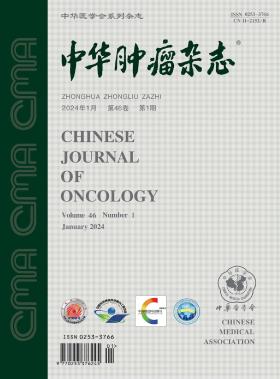[CMTM3通过NF-κB信号通路调控胶质母细胞瘤U251细胞的增殖和迁移]。
摘要
目的:探讨趋化因子样MARVEL跨膜结构域蛋白3 (CMTM3)对胶质母细胞瘤(GBM)细胞增殖和迁移的影响及其潜在机制。方法:利用肿瘤基因组图谱(TCGA)和基因型-组织表达(GTEx)数据库的CMTM3表达数据,分析CMTM3在GBM组织中的差异表达及其对患者预后的影响。对2022年11月3日至2023年3月15日在贵州医科大学附属医院接受手术治疗的11例GBM患者的GBM及邻近非癌组织样本进行CMTM3免疫组化染色及蛋白含量测定。此外,通过实时定量聚合酶链反应(RT-qPCR)和Western blot分析,验证了CMTM3在GBM细胞系U87、U251、LN229和人星形胶质细胞(NHA)细胞系中的表达。利用U251细胞构建CMTM3沉默和过表达的稳定细胞系(sh-CMTM3组和OE-CMTM3组)。采用细胞计数试剂盒-8 (CCK-8)法评估CMTM3表达对细胞增殖的影响。流式细胞术检测CMTM3表达对细胞周期的影响。Transwell实验评估CMTM3表达对细胞迁移的影响。通过生物信息学分析、Western blotting、NF-κB活化-核易位实验和NF-κB通路抑制剂吡罗烷二硫代氨基磺酸铵(PDTC)验证CMTM3对NF-κB通路的影响。最后,通过裸鼠皮下肿瘤发生实验,观察CMTM3表达对U251细胞体内生长的影响。结果:生物信息学分析显示CMTM3在GBM组织中高表达。与CMTM3低表达患者相比,CMTM3高表达患者的总生存率(OS)和无病生存率(DFS)较低(P值分别为0.010和0.032)。11例GBM病理标本中,有10例癌组织中CMTM3蛋白表达水平高于癌旁非癌组织。CMTM3蛋白平均表达量为0.44±0.09,显著高于癌旁非癌组织(0.12±0.02,P<0.001)。在一个样本中,癌组织与癌旁非癌组织CMTM3蛋白表达差异无统计学意义(P=0.750)。RT-qPCR结果显示,CMTM3 mRNA在NHA细胞中的表达量为1.0±0.1,而在GBM细胞U87、LN229和U251中的表达量分别为2.1±0.3、3.4±0.5和3.7±0.8,均显著高于NHA细胞(均P<0.01)。Western blot结果显示,CMTM3蛋白在GBM细胞U87、LN229和U251中的表达量分别为1.5±0.2、1.8±0.2和1.9±0.1,均高于NHA细胞(0.7±0.2,均P<0.01),其中以U251细胞表达量最高。CCK-8、流式细胞术、Transwell迁移实验结果显示,sh-CMTM3组细胞活力受到抑制,G0/G1期细胞比例增加(P<0.01), S期细胞比例减少(P<0.01),迁移细胞数为233.6±35.5个,低于sh-NC组(P<0.001)。相反,OE-CMTM3组细胞活力增强,G0/G1期细胞比例降低(P<0.01), S期细胞比例增加(P<0.01),迁移细胞数为1212.0±20.8个,高于OE-NC组(P<0.001)。而OE-CMTM3+PDTC组细胞活力、细胞周期分布(G1、S、G2期)、细胞迁移数量无显著变化(P < 0.05)。Western blot分析和NF-κB活化-核转运实验结果显示,sh-CMTM3组P -p65/p65比值为0.51±0.04,P -κB α/ i -κB α比值为0.39±0.03,均低于sh-NC组(P<0.01)。细胞质染色率为(49.29±1.98)%,高于sh-NC组(P<0.01)。OE-CMTM3组P -p65/p65比值为2.27±0.10,P - κ b α/ i - κ b α比值为2.14±0.15,均高于OE-NC组(P<0.01)。细胞质染色率为(18.96±1.44)%,低于OE-NC组(P<0.01)。OE-CMTM3+PDTC组P -p65/p65比值、P - κ b α/ i - κ b α比值、细胞质染色率与OE-NC组比较差异均无统计学意义(P < 0.05)。裸鼠皮下肿瘤发生实验显示,sh-CMTM3组肿瘤体积为(408.9±96.2)mm³,小于sh-NC组(P=0.003)。OE-CMTM3组肿瘤体积为(1 514.5±251.5)mm³,明显大于OE-NC组(P=0.005)。 结论:在GBM中,CMTM3高表达,且与患者OS和DFS呈负相关。CMTM3通过NF-κB信号通路调控U251细胞的增殖和迁移能力。Objective: To explore the effects and potential mechanisms of chemokine-like factor-like MARVEL transmembrane domain-containing Protein 3 (CMTM3) on the proliferation and migration of glioblastoma (GBM) cells. Methods: Using CMTM3 expression data from The Cancer Genome Atlas (TCGA) and Genotype-Tissue Expression (GTEx) databases, we analyzed the differential expression of CMTM3 in GBM tissues and its impact on the prognosis of GBM patients. Immunohistochemical staining and protein content determination of CMTM3 was performed on GBM and adjacent non-cancerous tissue samples from 11 GBM patients who underwent surgical treatment at the Affiliated Hospital of Guizhou Medical University between November 3, 2022 and March 15, 2023. Additionally, the expression of CMTM3 was validated in GBM cell lines U87, U251, LN229, and the human astrocyte (NHA) cell line using real-time quantitative polymerase chain reaction (RT-qPCR) and Western blot analyses. Stable cell lines with silenced and overexpressed CMTM3 (sh-CMTM3 group and OE-CMTM3 group) were constructed using U251 cells. The effect of CMTM3 expression on cell proliferation was assessed using the Cell Counting Kit-8 (CCK-8) assay. Flow cytometry was employed to examine the impact of CMTM3 expression on the cell cycle. Transwell assays were conducted to evaluate the influence of CMTM3 expression on cell migration. Bioinformatics analysis, Western blotting, NF-κB activation-nuclear translocation assays, and the NF-κB pathway inhibitor pyrrolidine dithiocarbamate ammonium (PDTC) were used to validate the effect of CMTM3 on the NF-κB pathway. Finally, a subcutaneous tumorigenesis assay in nude mice was performed to observe the impact of CMTM3 expression on the in vivo growth of U251 cells. Results: Bioinformatics analysis revealed that CMTM3 is highly expressed in GBM tissues. Patients with a high CMTM3 expression had lower overall survival (OS) and disease-free survival (DFS) rates compared with those with a low CMTM3 expression (with P values of 0.010 and 0.032, respectively). Among the 11 GBM pathological specimens, 10 samples exhibited higher CMTM3 protein expression levels in the cancerous tissue compared with the adjacent non-cancerous tissue. The average CMTM3 protein expression in these samples was 0.44±0.09, significantly higher than that in the adjacent non-cancerous tissues (0.12±0.02, P<0.001). In one sample, the difference in CMTM3 protein expression between the cancerous and adjacent non-cancerous tissues was not statistically significant (P=0.750).The RT-qPCR results showed that the mRNA expression level of CMTM3 in NHA cells was 1.0±0.1, whereas in GBM cells U87, LN229, and U251, the levels were 2.1±0.3, 3.4±0.5, and 3.7±0.8, respectively, all significantly higher than that in NHA cells (all P<0.01). Western blot results demonstrated that the protein expression levels of CMTM3 in GBM cells U87, LN229, and U251 were 1.5±0.2, 1.8±0.2, and 1.9±0.1, respectively, also higher than that in NHA cells (0.7±0.2, all P<0.01), with the highest level observed in U251 cells. The CCK-8 assay, Flow cytometry, and Transwell migration experiments indicated that cell viability was inhibited in the sh-CMTM3 group, with an increase in the proportion of cells in the G0/G1 phase (P<0.01) and a decrease in the S phase (P<0.01), and the number of migrated cells was 233.6±35.5, lower than that in the sh-NC group (P<0.001). Conversely, the OE-CMTM3 group showed enhanced cell viability, a reduction in the proportion of cells in the G0/G1 phase (P<0.01), and an increase in the S phase (P<0.01), and the number of migrated cells was 1212.0±20.8, higher than that in the OE-NC group (P<0.001). However, in the OE-CMTM3+PDTC group, cell viability, cell cycle distribution (G1, S, and G2 phases), and cell migration numbers showed no significant changes (all P>0.05). Western blot analysis and NF-κB activation-nuclear translocation assay results indicated that in the sh-CMTM3 group, the p-p65/p65 ratio was 0.51±0.04 and the p-IκBα/IκBα ratio was 0.39±0.03, both lower than those in the sh-NC group (both P<0.01). The cytoplasmic staining rate was (49.29±1.98)%, higher than that in the sh-NC group (P<0.01). In the OE-CMTM3 group, the p-p65/p65 ratio was 2.27±0.10 and the p-IκBα/IκBα ratio was 2.14±0.15, both higher than those in the OE-NC group (both P<0.01). The cytoplasmic staining rate was (18.96±1.44)%, lower than that in the OE-NC group (P<0.01). In the OE-CMTM3+PDTC group, there were no significant differences in the p-p65/p65 ratio, p-IκBα/IκBα ratio, and cytoplasmic staining rate compared with the OE-NC group (all P>0.05). The subcutaneous tumorigenesis assay in nude mice showed that the tumor volume in the sh-CMTM3 group was (408.9±96.2) mm³, smaller than that in the sh-NC group (P=0.003). The tumor volume in the OE-CMTM3 group was (1 514.5±251.5) mm³, larger than that in the OE-NC group (P=0.005). Conclusions: In GBM, CMTM3 is highly expressed and negatively correlated with both OS and DFS of patients. CMTM3 regulates the proliferation and migration abilities of U251 cells through the NF-κB signaling pathway.

 求助内容:
求助内容: 应助结果提醒方式:
应助结果提醒方式:


